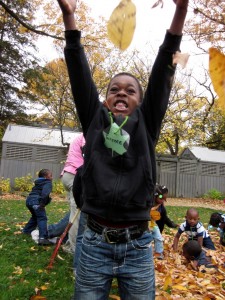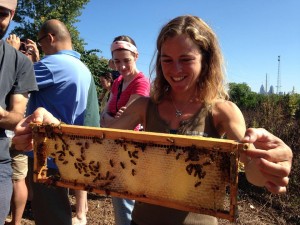Imagining a future for historic house museums, Part 2
20 May 2015 – editors
This piece is continued from part 1.
In Part 1 of this post, we discussed strategies employed by Philadelphia-area house museums for employing new methods and engaging new communities in order to repurpose and re-imagine historic house museums. In part 2 of this post, we will look at strategies for tackling challenging topics and using new technologies and techniques to realize these goals.
Facing difficult and controversial subject matter
History, as we all know, is complicated. Historic house museums have not always been places that embraced this complexity. But there is room, and indeed, a real need to transform these sites into places where visitors can be engaged in complex stories and begin to grapple with the sometimes difficult aspects of our past.
In Philadelphia’s Germantown neighborhood, one site has re-made itself over the past several years to do just that. Staff research in the site’s archives revealed that the Chew family was the largest slaveholding family in Pennsylvania. As they explored this aspect of the site’s history with their neighbors and community, it became clear that it was essential to tell this story and to interpret the extent to which the Chew’s family wealth and privilege were tied up with their status as slave owners. What resulted was the Emancipating Cliveden project, a combination of new programs, new exhibits and new multimedia that explores these issues as part of the house’s core interpretive message.
At Pennsbury Manor in Bucks County, Pennsylvania, an interest in interpreting the legacy of William Penn (as opposed to merely the relatively short time he spent at his estate in Pennsylvania) led site staff to redesign a more multifaceted view of the Walking Purchase, which exiled the Lenni Lenape people from Pennsylvania and establish a relationship with the Delaware Tribe of Indians, now in Oklahoma.
Effective / thoughtful use of technology
Perhaps the most obvious (and maybe over-discussed) strategy for engaging new audiences is to try to reach them through computer screens or smart phones. Although turning to technology can offer as many pitfalls as advantages (i.e. the myth that we can all reach young people by simply creating a Facebook page), imaginative use of social media, web projects, and cell phone apps does have the capacity to enliven stale interpretive methods and deliver complex messages with multiple perspectives. Other forms of high tech expression–like video and audio installations in house museums–when rigorously conceived and well produced–can conjure experiential veracity and wonderment in visitors not possible in other ways. Our program has funded a series of projects in the last few years that utilize these new media in effective ways.
Museum Without Walls, a project produced by Philadelphia’s Association for Public Art, provided opportunities for audiences to deepen their experience with public art on the Benjamin Franklin Parkway by calling a number on their cell phones to hear first person stories and background information on the art. This project could easily be adapted for historic buildings and neighborhoods.
The Rosenbach Museum & Library has used simple technology (a CD player and some speakers!) to create an audio component to their tours which allow visitors to hear the recorded voices of their founders and those represented in their collections, suggesting a ghost-like presence in the period rooms.
Playing with games and gaming
Everybody likes to play games and both technology-based and real-space games are emerging as sophisticated and fun interpretation strategies in public history. The American Philosophical Society, the oldest museum in the US, recently produced a geocaching game: a high-tech, smartphone-based scavenger hunt which sent audiences throughout old city in Philadelphia to imagine the historic landscapes and geographies which once existed there. At Fonthill, the historic home of Henry Mercer in Doylestown, Pennsylvania, staff prototyped a choose-your-own-adventure-based tour of the house which for the first time enabled visitors to control their own experience of the house and make decisions about their experience based on their own interests.
Becoming a center for creative learning and experience
Ultimately, we believe that house museums need to expand their missions beyond stewardship and interpretation to become centers for creative learning and experience. Historic buildings and collections will always be our primary concern, but to what purpose? We have seen house museums shift themselves from being at the periphery of a community (or even perceived as hostile territory) to being at the center of a community’s life. Wyck, a 1793 home and garden in the Germantown section of Philadelphia that housed six generations of a Quaker family, is now a small working farm with a weekly farmer’s market, healthy cooking classes, urban agriculture workshops, and a thriving school program focused on food growing and nutrition. Philly’s Bartram’s Garden and Grumblethorpe, both 18th-century historic sites, have developed in-depth environmental-based programming for families, linking with their low income neighbors through plant propagation programs, a community orchard, urban beekeeping courses, and teen writing projects.
Conclusion
These new approaches to programming at house museums have major implications for organizational change. New methods of engaging audiences mean a new set of skills for all of us involved with these organizations–from the board of directors to the executive leadership to the curatorial/program staff and front-line staff. House museum staff must now become experts in developing a dialogic relationship with their communities, including the immediate neighbors and a variety of other stakeholders.
These house museum “facilitators” will have to work across the traditional silos of the administrative, the curatorial, education, communications, etc. They will need expertise in how people play, contemporary artistic/cultural practice, and be comfortable with discussing uncomfortable subjects, imaginative and thoughtful approaches to applying technology, and perhaps, above all, to research, talk with, and understand our existing and potential audiences. These new skills are becoming as important to the functioning of a healthy house museum as any content or preservation expertise.
As the knowledge and abilities of house museums staff shift, so too will the operational structure and leadership need to be adjusted. What kinds of staffing and leadership structures will best support these new kinds of activities? All constructive readjustments should be considered as we let go of the no-longer-working and make room for the experimental, the imaginative–the future.
~ Bill Adair and Laura Koloski are public historians in the Philadelphia region. They are the co-editors, with Benjamin Filene, of Letting Go? Sharing Historical Authority in a User-Generated World (Left Coast Press, 2012).






“Reconstruction and the House Museum” (http://werehistory.org/house-museum/) discusses other opportunities to address complex and difficult history at house museums.